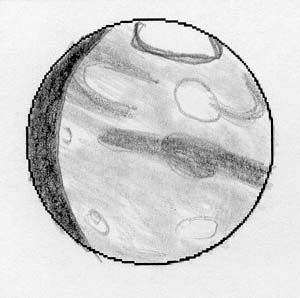
Sketched July 15, 2003 from my back deck 4:30 a.m. pacific DST (daylight savings time) or 11:30 UT.
| Date: 07/15/03 Lat 37.6N, Long 122W, elev. 200 feet | Sketch Time (UT): 11:30, (local time): 4:30 a.m. DST |
| Central Meridian: 174° | Filters: none |
| Instrument: 4-inch (105mm) f/6 Astro-Physics Traveler Apo refractor. | Distance from earth 0.49 AU, 74m km, 46m miles |
| Magnification: 376x (4mm Zeiss Abbe Ortho, 252x (6mm Zeiss Abbe Ortho, 151x (10mm Zeiss Abbe Ortho combined with a 2.4x AP Barcon Barlow | Transp. 3/6, Seeing 9/10, Antoniadi (I-V): I - II |
| Apparent Size: 19.24" | Magnitude: -1.9 |
South Polar cap (top) is ringed with a dark melt line, the area of Martian earth uncovered as the polar cap receeds. Below and to the right of the south polar cap (north and to the far right) is a horseshoe-shaped feature and a white spot. White spot is Eridania, and inside the "u" is Ausonia. dark "U" is Mare Tyrrhenum. Notice how they have rotated since the previous sketch! North (below) is the albedo feature Mare Siremum (the lump) tapering to Mare Cimmerium. A new ""C" shaped feature is rotating on. Different Mars maps show this as Mare Chromium or Phaethontis. I think Phaethontis is the lighter area in the middle of the "U". Aonius Sinus is rotating on. I guess I have some homework with a Mars globe now. Bottom left is a light area most people assume is not visible in small telescopes. Olympus Mons the largest volcano in our solar system. What we actually see is clouds above the caldera, not the volcano itself. Still it is pretty cool! The other white spot on the right bottom is called Chaos.
Mars, in this sketch is reversed N/S. South is shown at the top of the image. The south polar cap is the prominent feature. Terminator is where daylight ends and evening begins. The terminator is on the left and the planet is rotating left to right. In my sketches the planet rotates martian east (left) to west (right) to match most other images and sketches. Look for features rotating from left to right in the drawings.
Details about Mars: Diameter 19.24 arc seconds (Jupiter is about 30 -50 arc seconds in diameter depending on its distance from earth). Central Meridian 174 - the imaginary line passing through the planetary poles of rotation and bisecting the planetary disk, and is used to determine the longitude during an observing session.

White Oaks Home | Sketches Index | Mars 2003 Index | Back | Next